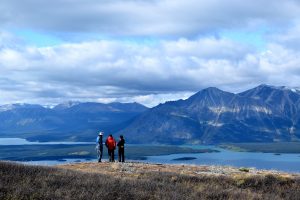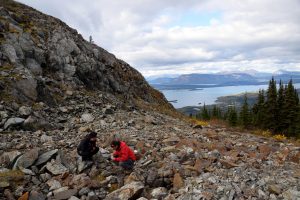14 September 2016
The Atlin Ophiolite Rocks
Posted by Nanci Bompey
By Rebecca Fowler
This is the third in a series of dispatches from Rebecca Fowler, a science writer documenting the work of scientists conducting fieldwork at the Atlin ophiolite in British Columbia. Read her other posts here and here.

Scientists Ian Power, Andreas Beinlich and Masako Tominaga discuss possible sampling sites on the summit of Monarch Mountain in Atlin, British Columbia.
Credit: Rebecca Fowler
On a slightly overcast day last week, four of us set out to climb a mountain. On the hike were Masako Tominaga, a geophysicist from Texas A&M University, Andreas Beinlich, a geochemist from Curtin University, Ian Power, a geochemist from the University of British Columbia and myself. The fifth member of our team, the ever-cheerful Texas A&M University graduate student, Estefania (Fani) Ortiz, returned to College Station for a school commitment midway through our expedition.
We were in Atlin, British Columbia to carry out geophysical characterizations of Atlin’s mantle rocks and their alteration processes, collect rock samples for analyses to verify the geophysical work, and conduct field mapping of the outcrops and boundaries between rock types.
The four of us were still upbeat after three days of investigating outcrops reached by walking through forests and dense undergrowth, guided by a well-intentioned but sometimes inaccurate geological map, which often left us far from where we wanted to be. Despite the joy that comes from long hikes in the woods, and the excitement of finding new things, my scientist friends still wanted to find outcrops that weren’t covered by vegetation.
We’d successfully collected data and samples at these outcrops, but Masako and Andreas were hoping to find a site where they could more clearly see the boundaries between types of mantle rocks—peridotite to serpentinite, serpentinite to listvenite. This would enable them to study exactly how these rocks change from type to another, a process known as serpentinization.

Masako Tominaga uses a magnetic susceptometer to measure the amount of magnetic minerals in an outcrop of serpentinized harzburgite atop Monarch Mountain.
Credit: Rebecca Fowler
Atlin’s Monarch Mountain showed promise. We could see from ground level that the mountain’s outcrops were exposed above the tree line. Ian, who had been to the summit during previous fieldwork in Atlin, thought it would be a good site. And the mountain has a trail.
The steep, two-hour hike up the mountain was rewarding, and not just for the views of Atlin Lake and the mountains rising around it. Exposed outcrops of peridotite, serpentinite and listvenite gave Masako and Andreas plenty of locations to examine. Most of our day was spent wandering the summit, inspecting and collecting rocks, recording magnetic data and noting the locations of sites, which Masako and Andreas will investigate further during their 2017 fieldwork.
This was our final, and perhaps most productive day in the field. One day later, we left Atlin with more than 40 rock samples from various outcrops. Over the next few months a portion of these samples will become thin sections, which Andreas will use for petrological and geochemical analysis. Masako and Fani will use this same suite of samples to examine the rock magnetic and other physical properties, such as density analyses, to determine exactly what types of rock these are today, and what type they once were.
Our fieldwork is the first step in a long process that will slowly reveal more about serpentinite carbonation in this ophiolite complex. Although there’s considerable lab work to be done before specific conclusions can be made, Masako and Andreas have preliminary findings about the location and nature of Atlin’s outcrops as the result of the many miles we walked.
The two scientists have studied ophiolites in Norway and elsewhere; Masako says she has confidence that some of the processes occurring in the Norway and Atlin ophiolites may be globally applicable. But there are also differences. “In Atlin, we’re seeing dunite channels everywhere and they’re being serpentinized,” Masako said. “This is eye-opening, because it means the serpentinization process, specifically of peridotite becoming serpentinite, is more complicated than our hypothesis model.”

Masako Tominaga and Andreas Beinlich inspect a sample of serpentinite found near the top of Monarch Mountain. Credit: Rebecca Fowler
Another task for these researchers is updating the geological map of Atlin with the new information we gathered about its outcrops and rock boundaries. Despite the confused state the map occasionally left us in, verifying and refining it was one of the objectives of our fieldwork—and that goal has been met. The new map will be used during the group’s 2017 fieldwork, but updating it will benefit other researchers as well. With the growing interest in carbon sequestration, Masako and Andreas are not the only scientists studying the Atlin ophiolite.
This team of scientists is fortunate to be able to return to Atlin in 2017 for a second field campaign, also focused on investigating natural carbon sequestration processes. In the coming months, Masako and Andreas will use the data and samples collected on this trip to adjust their fieldwork strategy and address their hypotheses—and the challenges we encountered along the way only add to their research. “This field campaign showed us that the knowledge we can obtain from Atlin is infinite,” Masako said. “What we learn from these sites depends just on the project implementation and one’s ability to articulate this knowledge.”
Thanks for reading our field reports and to the National Science Foundation for supporting this project. You can find more photos from our expedition on the AGU Instagram account (search for #Atlin16). We hope you’ll follow along when we return to the field in 2017.
— Rebecca Fowler is a science writer who divides her time between freelance projects and communications for Columbia University’s Center for Climate and Life.


 GeoSpace is a blog on Earth and space science, managed by AGU’s Public Information staff. The blog features posts by AGU writers and guest contributors on all sorts of relevant science topics, but with a focus on new research and geo and space sciences-related stories that are currently in the news.
GeoSpace is a blog on Earth and space science, managed by AGU’s Public Information staff. The blog features posts by AGU writers and guest contributors on all sorts of relevant science topics, but with a focus on new research and geo and space sciences-related stories that are currently in the news.